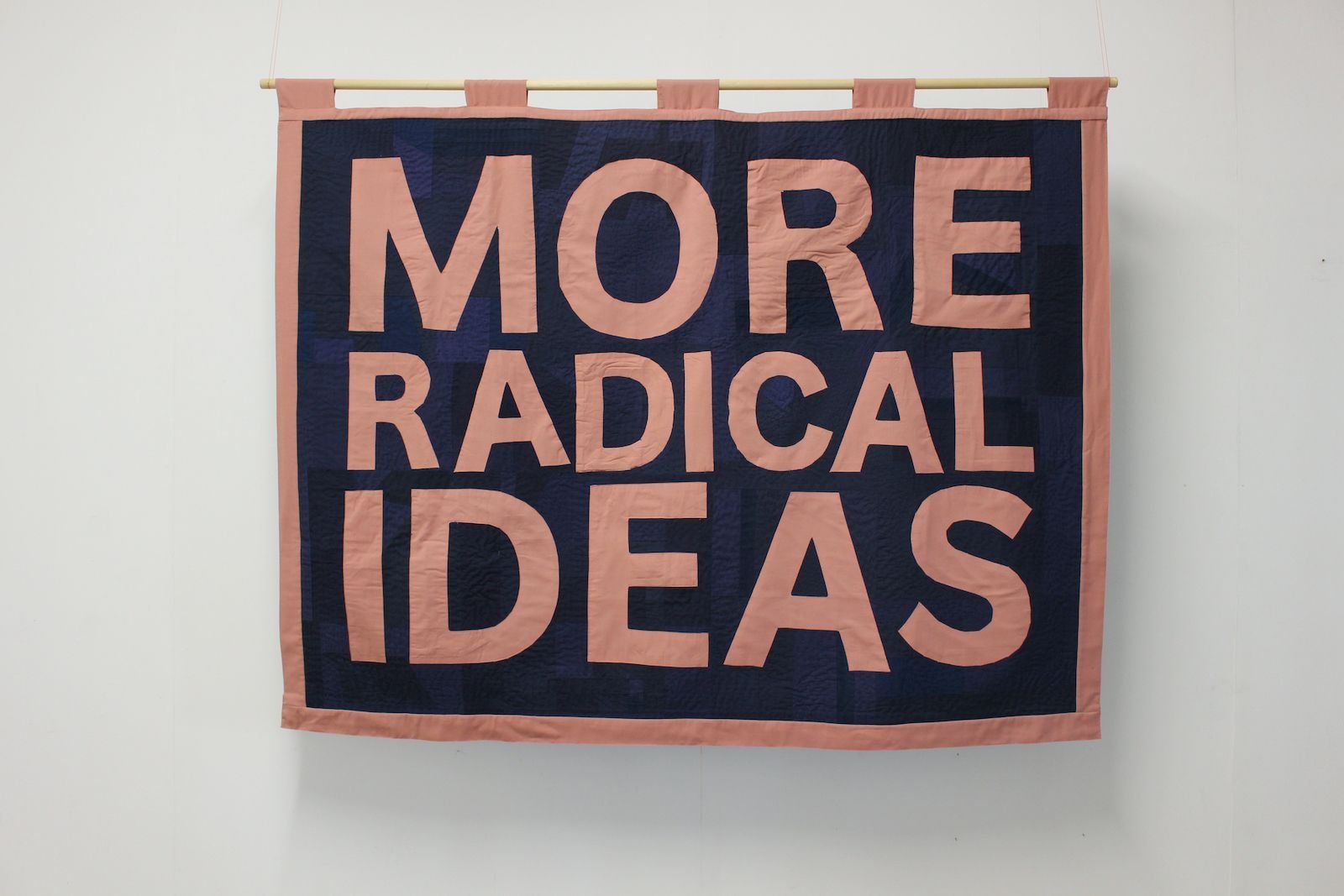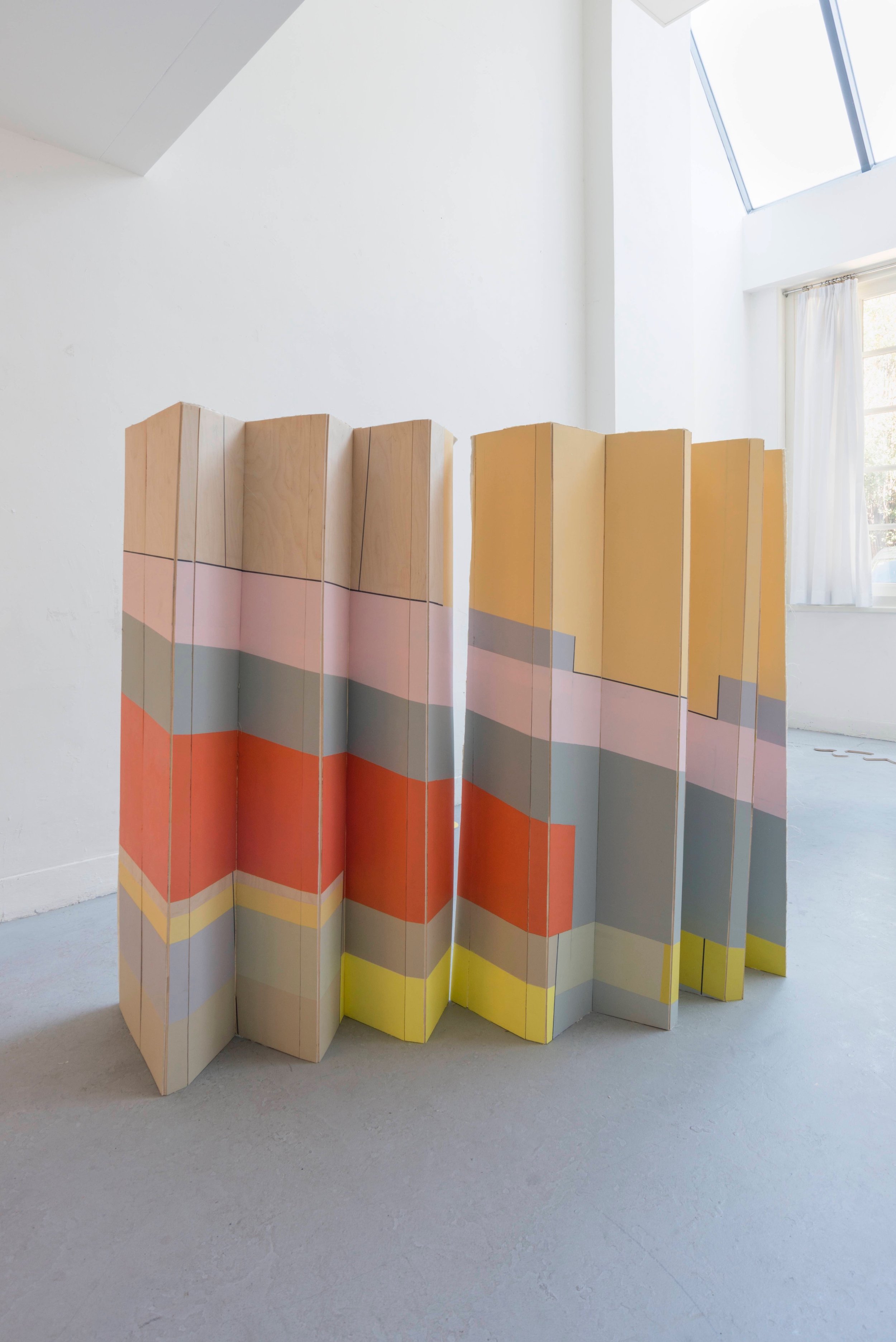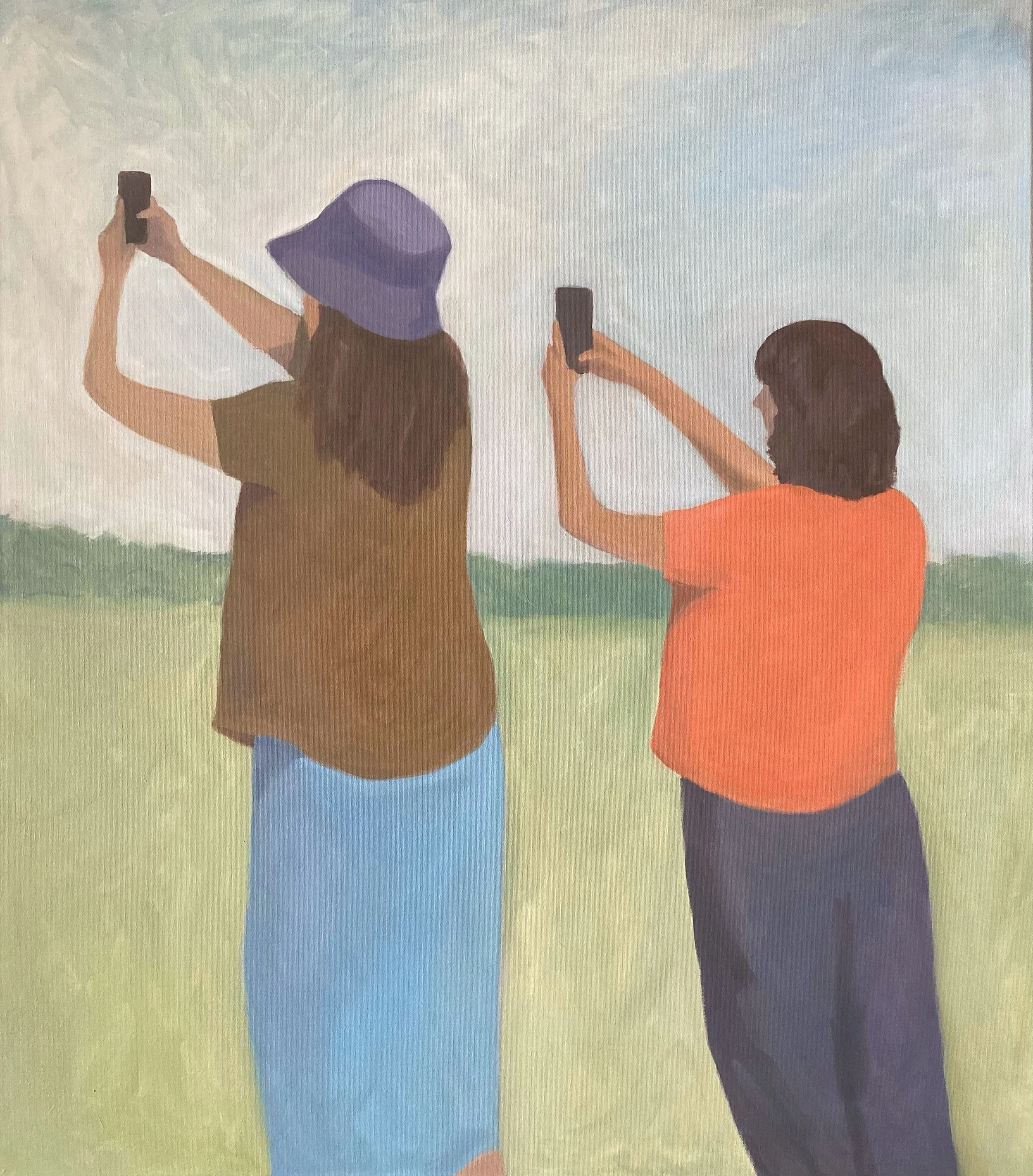













Overall Award Winner 2024
SHARPis a queer artist, activist and producer whose works stem from photography and an archive of imagery that dates back to the 1980’s. From this anchor point they have expanded into video, installation, performance and sculptural intervention as a means to occupy space. Their works originate from a vital urge to document their life, their butch identity, and the spaces around them, often utilising the varied codes and symbols used by LGBTQIA+ people due to historic criminalisation and repression.
Their string of 15 Cherry Red Dr Martens boots, are inspired by the common street action of hanging shoes from a telephone line to mark territory. Synonymous with lesbian counterculture, they serve to claim this as a queer space and to mark the 15 years that Section 28 infringed on the liberties of LGBTQIA+ people.
A blurred photograph of daffodils in motion was Scanned from an original negative first taken in 1988, to capture a sense of isolation that is transformed into collective movement. Its new iteration bears scratches and markings gathered over the intervening years, like scars telling of time, trauma and a history of repression. SHARP reclaims the word Daffodils, once used as a slur against queer people, as a positive celebration of queers dancing together.
@sharp_the_artist

Additional Award Winner 2024
Henry Miller is an artist, actor, and passionate lover of music.
His paintings are often based on the covers of records selected from his extensive collection or else from magazine images or other music related ephemera. Chosen both for the formal qualities of their iconic, intriguing or obscure covers, and for their personal history and meaning for him, they form a catalogue of cultural obsessions, often painted while listening along to the artist in question, whether onto a conventional ground, a scrap of card, or a recycled grocery box.
Much like his acting practice, he recognises that improvisation is key to this work, as he considers character, story, gesture and movement, while trying to transmit the essence of the music into the visuals he creates. Remembering as he paints, he would like the viewer to be entertained, surprised, to discover new things and feel a connection. Where they were when they heard that song. The time and place. The familiar bringing them to their past.
@millertown1

Audience Choice Award Winner 2024
Nicola Bealing is a painter, printmaker and occasional maker of sculptural installations based in Cornwall, whose work is figurative, anchored strongly in narrative, laced with dark humour and pulsing with surreal unease.
Despite their vastly differing scale, the paintings featured here both depict a kind of end point, when all that possibly can, has gone wrong with the world.
While much of the artist’s work depicts things which might be on the brink of going wrong, her large painting 'The World - Upside Down' has gone beyond the tipping point and there has been a cataclysmic flip. Everything is inverted, a raucous pitch invasion of musical skeletons swarms out of the darkness while a spinning chorus of unidentified deities looks on with alarm. In the diminutive work 'The World - Leaving' the world is skipping away, like a bored guest at a party, it has had enough.
@nicola_bealing

Milly Peck’s practice encompasses drawing, painting, installation and sculpture. Fundamentally she is interested in exploring the slip back and forth between two and three dimensions, particularly the relationship between theatre and architecture, and how the physical stage functions as a framing device demarcating audience from actor, and reality from artificiality.
Applying this idea of framing or layering to architecture at large aims to call into question our day-to-day understanding and physical experience of our own reality. These works rebuild and reinvent existing architecture, incorporating the aesthetic qualities of set design and model-making. They respond to – and reimagine – the existing urban and architectural environment within the everyday, domestic landscape. The artist’s process of collaging a variety of materials and surfaces, aims to emphasise the sense of something temporary, moveable or even collapsable, much like a live theatrical set with its exaggerated perspectives and layered backdrops, to hint at a potential action or use.
@millypeck

LOW PROFILE are artists Rachel Dobbs (IRL) and Hannah Rose (UK) who have worked in collaboration since 2003. They are interested in the connections between people, and creating new experiences that happen in people’s real lives. Using bold statements, text, badges, sound, temporary gatherings, and event-structures to help do this, they make art that is designed to be encountered in everyday social situations and public spaces. They strive to make these encounters hopeful, engaging, joyful and thought-provoking, celebrating the strength of coming together, commarardie, resourcefulness, resilience, generosity, loyalty and not giving up.
The banner works exhibited here draw on histories of radical quilting, union banner making and protest. They were created with multiple community participants during relaxed making sessions, in which the artists guided conversations around celebrating the power of coming together to achieve change through community building, group effort and collective action.
@hellolowprofile

Arun Sood is a Scottish-Indian artist, academic, writer, and musician whose research and practice engage with themes of postcolonialism, ancestry, language, and memory. His collaged images explore the European exceptionalism that sought to dismiss the deep knowledge and rich cultures of India that predated, and continued to exist, alongside colonial rule. They are based on film stills from the 1940’s newsreel Indian News Parade, produced by the Indian government in the run-up to independence in response to more Anglo-centric newsreels created by British companies. These are layered with fragments of an ancient Sanskrit text on medicine, and extracts from C19th essayist and historian Thomas Macaulay. They are worked into by hand with red pigments, crushed pastels, and tape to evoke bloodstain and censorship, masking, as well as to dismantling and disrupting knowledge hierarchies. The accompanying single channel sound work layers contemporary instrumental compositions with field recordings from Sood’s time spent in Bengal, and spoken word fragments drawn from Bengali polymath, Rabindranath Tagore’s poem ‘Day’s End’.
@arun_sood

Lynn Fulton’s sculptures come from an underlying interest in the overlooked or the thing that is left behind. Shifting between the familiar and the unknown and playing with flatness and three dimensionality, she references objects and situations encountered in other contexts, such as in how landscape lies or how drapery falls curtains or clothing. Fulton is interested in how sculpture may have multiple ways of existing and being seen, the performance of folding, unfolding, and displaying, the connections between these states and the potential of the passive form, waiting to be activated.
These works consider how curtains may act as dividers or thresholds between one space and another, and how the act of veiling or covering hides, but also makes present what lies beneath; the surface which wraps and slides over something. Through a process of cutting and articulating flat material her forms emerge, making physical something which is transient and not really there, and in turn, they can take varied forms and are not fixed or finite when staged for exhibition.
@lynncfulton

Laura Wormell develops her paintings through a practice of ‘commonplacing’ - filling her studio with visual quotations in the form of drawings from a wide range of sources (Victorian childrens books, google stock photos, fetish magazines, Old Master paintings, illuminated manuscripts) from which she then draws to make an inquiry in paint.
In this series she explores the relationship between symbols and imagery, examining how letters and text, as abstract representations, function through the form of figurative painting. The painted texts are difficult to decipher, from elaborate and decorative fonts to manipulated human figures forming letters, which create a dialogue between the body as image and the letter as symbol.
Through the convergence of symbol and image, she aims to examine how these fundamental elements of human communication intertwine and influence perception and to raise questions about how meaning is constructed and conveyed.
The quotations in these paintings are taken from John Webster's play The Duchess of Malfi, which is littered with quotes from other literary works to emphasise the themes within the play. An absurd and tragic story of male revenge against a ‘lusty’ widow, the artist has been exploring both contemporary and modern-day interpretations of its portrayal of a woman with a will of her own.
@laura.wormell

Ruth Calland is a multidisciplinary artist who has been exploring gender, and their sense of gender identity, for as long as they can remember. They currently make paintings based on images produced by and about trans people, often using Tiktok to source this material.
By pausing the flow and movement of online imagery Calland aims to find a still point of reflection, focusing intensively on one moment or image, and aligning their own exploration of painting with the creative freedom witnessed in others. Exhilarated and deeply resonating with the imagery of others who feel their existence to be precarious, yet liberated, Calland aims to celebrate and amplify the revolutionary creative freedom espoused and embodied by many trans people. In connecting with those who use natural settings for their content, outdoor places with plants, flowers and trees, they aim to emphasise a sense that what is ‘natural’ is being redefined - what they think of as the ‘New Natural’.
@ruthcalland

Jess Scott is an artist and filmmaker who uses visual storytelling methods to retell and subvert traditional narratives, often re-contextualising existing images by ‘cutting them up’ and ‘sticking them back together’. They are motivated by an exploration of their own identity as a queer Christian, as they navigate becoming a young woman and an artist.
The self-portrait images from their ‘My father’s daughter’ series stem from research into the historical gender gaps and treatment of women in both art history and religion, and which may continue into the modern day. Influenced by specific historic cases of women artists who were only ever recorded by their father’s name, they are shot on a camera that their father first owned as a young man and depict the artist as they attempt to strip away their own identity by cropping their hair short and wearing his clothes.
@ink_stain_hands

Min Angel is an artist whose practice is concerned with the big stuff, our being-ness and consequently, inevitably with the small stuff - our being-ness. She is curious about the cosmos, consciousness, interconnectedness and the otherworldly; about storytelling, myths and belief systems and how these ideas and histories permeate our cultures and daily lives.
Treading the line between painting and drawing, figuration and abstraction, she uses colour, mark-making, repeated motifs, materials, found objects and touch to consider 'being'. Working intuitively, tapping into her imagination, as well as experiential and book-learned knowledge, she navigates what was, what if and the maybe, to find in the making what is and to feel alive. Her painting explores two repeated motifs - the dot (an oval) and the dash (a broken line) which, being conscious of archetypal forms of eggs, stones, cells and early language systems, are used as metaphors for life. They serve here as containing, holding and framing devices, and as protagonists within the painting field.
@minangelartist

Monica Perez Vega's paintings explore ideas of uncertainty and adaptation, through imagined landscapes that sit between nostalgia and unease. Originally from California, memories of home are warped by changing landscapes and experiences of continually starting over, leading to a practice which investigates cycles of change. Interested in the precipice between renewal and collapse, she relies on disruption as a search for hope amid precarity. Recent works have explored ways to ‘green’ the artist’s practice, using natural inks and pigments including handmade acorn husk ink and repurposed canvases.
These works spring from research that considers significant ancient trees from around the UK, fungal networks that create sporadic, collaborative communities, and ideas about mud - as the marvellous result of the world thawing into Spring, the joyful, reckless abandon of playing in mud, but also of being stuck in the muddy thick of things and considering the impetus to slog onward, to persevere. Anthropomorphic ideas of the tree as a figure which tells a story of steady resilience or, as a ‘headless’ stump, the embodiment of disruption, where new life also quietly resides, can also elicit memories of home, act as markers of time, and can represent an aspiration for rootedness.
@monicaperezvega

Iñaki Susbielles is an Argentinian artist who has been based in the UK since 2020. His paintings explore human emotions and behaviours, such as authenticity, vulnerability and humour, which are often played out through contemporary domestic situations that may seem somehow staged or uncanny. Using lived experiences, memories, color, light and shapes from contemporary life to build his narratives, he also makes connections and references to art history. He aims to capture the essence of intimate, everyday life - those spare, unnoticed situations where there is a stillness and mystery that will also resonate both with himself and with the viewer, allowing each to observe and reflect.

Laura Hopes’ expanded practice encompasses writing, conversations, film, performance, installation and multi-disciplinary exchange, often achieved through extensive collaboration. Her research focuses upon the implicit relationship between climate change and colonisation, particularly through land practices including agriculture and urbanisation.
Her Flock Stone sculptures mimic the ancient granite stone forms found scattered across Dartmoor, whether nestled naturally in the landscape, or forming its iron-age circles, animal pounds, lone farmhouses and once-prosperous market towns, originally built on the wealth derived from the wool trade. Made of undyed sheeps’ wool, sourced from the same landscape, they also suggest the company and animacy of sheep. In clustering together or in isolation, the sculptures may suggest the idea of a flock, one that might scatter away from you, lead you, shelter you from sidelong winds, might form a wall.
@laurahopes

Yeon Sung Lee is a London-based South Korean artist whose paintings aim to capture unsettling figures and landscapes of the Anthropocene epoch – a new geological era marked by man’s indelible presence on the planet. He aims to capture a world in which the boundaries between human and non-human elements are deeply intertwined and it is impossible to find a place that has not been profoundly affected by human influence. By embracing painting techniques that are unpredictable or hard to control, he aims to move beyond conventional depictions of picturesque nature. Instead, he merges elements to create landscapes that reflect the chaotic intersections of socio-political, economic, and environmental factors.
These works are from a series that depict the Kiribati waterfront, a Micronesian island in the Pacific which is predicted to be one of the first nations to lose its land due to rising sea levels. Yeon’s focus is on the crisis happening now, depicting people interacting with their rapidly changing landscapes.
@yeonslee
